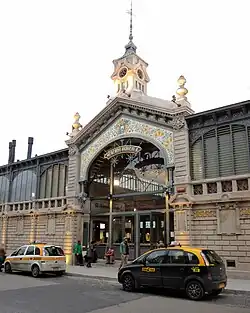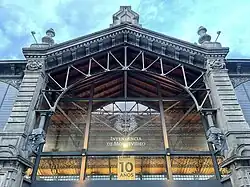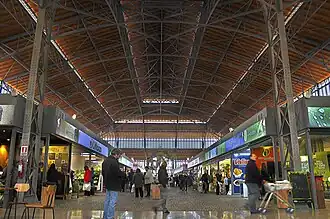Mercado Agrícola de Montevideo
 Mercado Agrícola in 2013 | |
| Coordinates | 34°53′13″S 56°11′00″W / 34.88694°S 56.18333°W |
|---|---|
| Address | 2220 José Terra Street |
| Architect | Antonino Vázquez and Silvio Geranio |
| Environment | Covered |
| Website | www |
The Mercado Agrícola de Montevideo (MAM) (English: Montevideo Agricultural Market) is a historic enclosed market in the Aguada neighborhood of Montevideo, Uruguay. Built in the 1910s and reopened in 2013, it combines a variety of permanent shops selling fresh produce, butcheries, and other specialty food stores typical of a fruits and vegetables wholesale marketplace, along with general service providers and several restaurants and cafés.[1]
History
Construction of the Montevideo Agricultural Market began on 30 December 1906, on land donated by landowner Carlos H. Crocker. The project, designed by architect Antonino Vázquez with later contributions from Silvio Geranio, was conceived in line with the architectural trends of the period, drawing particular inspiration from European iron-market structures such as Les Halles in Paris.[2]

The main iron structure, covering 5,867 square meters, had originally been used at the International Exhibition in Brussels and was gifted to President José Batlle y Ordóñez during an official visit to Belgium.[3] Transported from England, it was assembled on-site in Montevideo using cast-iron columns and steel trusses.[4] The building was officially inaugurated on 30 November 1912, and became operational the following year.[5] From its inception, the market was regarded as one of the most significant examples of its kind in Latin America and marked the last major iron market hall constructed in the city.[6]

In 2010, a comprehensive restoration plan was approved. The building was reopened in June 2013, following extensive architectural intervention.[7] Since then, it has operated as a retail market primarily focused on the sale of fruits, vegetables, fresh produce, and other food items, and includes a gastronomic area along with shops offering handicrafts and souvenirs.[8] The main entrance features a decorative composition in European polychrome ceramic, prominently displaying the coat of arms of Montevideo, flanked by floral motifs. This façade is further distinguished by a central tower resembling a bell tower, topped with a spire, a wind rose, and a weather vane.[9]
In 1999 the building was declared a National Historic Monument.[10]
Gallery
-
 Main façade
Main façade -
 Food court
Food court -
 Market's corridor
Market's corridor -
 Market's stores
Market's stores -
Stall
References
- ^ "Mercado Agrícola de Montevideo | Municipio C". municipioc.montevideo.gub.uy. Archived from the original on 23 March 2023. Retrieved 24 July 2025.
- ^ "MERCADO AGRÍCOLA | Montevideo Audiovisual". mvdaudiovisual.montevideo.gub.uy. Archived from the original on 6 July 2022. Retrieved 25 July 2025.
- ^ "Revista Raices - Mercado Agrícola de Montevideo". www.raicesuruguay.com. Retrieved 25 July 2025.
- ^ "Mercado Agrícola de Montevideo | Portal institucional". montevideo.gub.uy. Retrieved 25 July 2025.
- ^ pais, uruguay marca (1 July 2013). "Así quedó el nuevo Mercado Agrícola Montevideo MAM". Uruguay Natural Marca Pais - Sitio Oficial (in European Spanish). Archived from the original on 13 May 2025. Retrieved 25 July 2025.
- ^ "Patrimonio | Mercado Agrícola De Montevideo | Montevideo". My Site (in Spanish). Archived from the original on 25 June 2025. Retrieved 25 July 2025.
- ^ "Mercado Agrícola renace tras ocho años de obras con una innovadora propuesta de servicios". Presidencia Uruguay (in Spanish). Retrieved 25 July 2025.
- ^ "Mercado Agrícola ofrece sus locales". EL PAIS. 19 July 2012. Retrieved 25 July 2025.
- ^ "Mercado Agrícola de Montevideo - Sociedad de Arquitectos del Uruguay" (in Spanish). Retrieved 25 July 2025.
- ^ "Un espectáculo para tus sentidos". Revista Importa que lo sepas (in Spanish). Retrieved 25 July 2025.